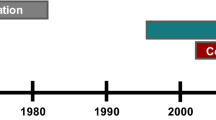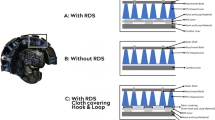Abstract
The purpose of this study is to explore the bilateral kinematic patterns across the posterior aspect of the medium National Operating Committee on Standards for Athletic Equipment anthropomorphic test device headform during blunt impacts. Such information is important for interpreting and properly deriving blunt impact performance metrics. Two medium National Operating Committee on Standards for Athletic Equipment headforms modified according to National Operating Committee on Standards for Athletic Equipment document ND-081 were attached to a male 50th percentile Hybrid III neck and were impacted at 14 locations along the posterior aspect of the headform (7 ear side, 7 non-ear side). Impacts were performed on a pneumatic linear impactor at 2, 3, and 4 m/s using the impactor head specified by the Standard Pneumatic Ram Test Method Document 081-18am. The peak linear acceleration, peak angular acceleration, and peak angular velocity values were quantified for each impact. The results indicate that peak linear acceleration seems to be consistent, peak angular acceleration is markedly less at the nape and rear regions, whereas peak angular velocity is greatest at the nape and rear regions. Additionally, there are numerous instances where the values between impacts to the ear side of the headform differ from impacts to the non-ear side according to our type-I error rate (alpha = 0.05). Our results provide an indication that there is a large variation in peak angular acceleration at different impact sites across the headform compared to little variation in peak linear and peak angular velocity. Additionally, there are some asymmetries present in the headform that may have clinical relevance for peak linear accelerations and peak angular accelerations, but not for peak angular velocity in the range of values we observed in this study.




Similar content being viewed by others
Data availability
Data available on request from the authors.
References
Yoganandan N, Pintar FA, Zhang J, Baisden JL (2009) Physical properties of the human head: mass, center of gravity and moment of inertia. J Biomech. https://doi.org/10.1016/j.jbiomech.2009.03.029
Hodgson VR (1975) National Operating Committee on Standards for Athletic Equipment football helmet certification program. Med Sci Sports 7:225–232
NOCSAE (2012) Standard pneumatic ram test method and equipment used in evaluating the performance characteristics of protective headgear and face guards (ND 002-11m11a)
Tyson AM, Rowson S (2018) Varsity football helmet STAR protocol. Virginia Polytechnic Institute And State University, Blacksburg
NFL (2021) Helmet Laboratory Testing Performance Results. NFL
Biomechanics Consulting & Research, LLC (Biocore) (2020) Helmet Test Protocol, March 2020
Bland ML, McNally C, Zuby DS, Meuller BC, Rowson S (2020) Development of the STAR evaluation system for assessing bicycle helmet protective performance. Ann Biomed Eng 48(1):47–57. https://doi.org/10.1007/s10439-019-02330-0
Rowson S, Duma SM (2011) Development of the STAR evaluation system for football helmets: integrating player head impact exposure and risk of concussion. Ann Biomed Eng 39(8):2130–2140. https://doi.org/10.1007/s10439-011-0322-5
Bland ML, McNally C, Rowson S (2018) Headform and neck effects on dynamic response in bicycle helmet oblique impact testing. IRCOBI Conference. IRC-18-69, pp 413–423
Cobb BR, Zadnik AM, Rowson S (2016) Comparative analysis of helmeted impact response of Hybrid III and National Operating Committee on Standards for Athletic Equipment headforms. J Sport Engin Tech 230:50–60. https://doi.org/10.1177/1754337115599133
Begonia MT, Pintar FA, Yoganandan N (2018) Comparison of NOCSAE head kinematics using the Hybrid III and EuroSID-2 necks. J Biomech 80:37–44. https://doi.org/10.1016/j.jbiomech.2018.08.018
National Operating Committee on Standards for Athletic Equipment (2013) Standard performance specification for newly manufactured football helmets. ND 002-13m13
National Operating Committee on Standards for Athletic Equipment (2020) Standard pneumatic ram test method and equipment used in evaluating the performance characteristics of protective headgear and face guards. ND 081-18am20
National Operating Committee on Standards for Athletic Equipment (2021) Standard pneumatic ram test method and equipment used in evaluating the performance characteristics of protective headgear and face guards. ND 081-18am21
Higgins M, Halstead DP, Snyder-Mackler L, Barlow D (2007) Measurement of impact acceleration: mouthpiece accelerometer versus helmet accelerometer. J Athl Train 42(1):5–10
Koncan D, Post A, Gilchrist M, Hoshizaki TB (2018) Comparison of two anthropomorphic test devices using brain motion. J Sport Eng Technol 232(4):305–314. https://doi.org/10.1177/1754337117751741
Rowson S, Duma SM, Beckwith JG, Chu JJ, Greenwald RM, Crisco JJ, Brolinson PG, Duhaime AC, McAllister TW, Maerlender AC (2012) Rotational head kinematics in football impacts: an injury risk function for concussion. Ann Biomed Eng 40:1–13. https://doi.org/10.1007/s10439-011-0392-4
Knowles BM, Dennison CR (2017) Predicting cumulative and maximum brain strain measures from Hybrid III head kinematics: a combined laboratory study and post-hoc regression analysis. Ann Biomed Eng 45(9):2146–2158. https://doi.org/10.1007/s10439-017-1848-y
Anderson ED, Sebastian JG, Wu T, Panzer MB, Meaney DF (2020) Predicting concussion outcome by integrating finite element modeling and network analysis. Front Bioeng Biotechnol 8:309. https://doi.org/10.3389/fbioe.2020.00309
Zhang L, Yang KH, King AI (2004) A proposed injury threshold for mild traumatic brain injury. J Biomech Eng 126(2):226–236. https://doi.org/10.1115/1.1691446
Holbourn AHS, Edin MA, Oxfd PD (1943) Mechanics of head injuries. Lancet 242(6277):438–441. https://doi.org/10.1115/1.1691446
Kimpara H, Iwamoto M (2012) Mild traumatic brain injury predictors based on angular accelerations during impacts. Ann Biomed Eng 40(1):114–126. https://doi.org/10.1007/s10439-011-0414-2
Kimpara H, Nakahira Y, Iwamoto M, Rowson S, Duma S (2011) Head injury prediction methods based on 6 degree of freedom head acceleration measurements during impact. Int J Auto Eng 2(2):13–19
Kendall M, Evan S, Walsh ES, Hoshizaki TB (2012) Comparison between Hybrid III and Hodgson-WSU headforms by linear and angular dynamic impact response. J Sport Eng and Technol 226:260–265. https://doi.org/10.1177/1754337112436901
Padgaonkar AJ, Krieger KW, King AI (1975) Measurement of angular acceleration of a rigid body using linear accelerometers. J Appl Mech 42(3):552–556. https://doi.org/10.1115/1.3423640
Wright AD, Laing AC (2012) The influence of headform orientation and flooring systems on impact dynamics during simulated fall-related head impacts. Med Eng Phys 34(8):1071–1078. https://doi.org/10.1016/j.medengphy.2011.11.012
Hrysomallis C, McLaughlin P (1999) Risk of head injury from falls on taekwondo mats. In: 17 Intl Symp Biomech Sport. ISBS, pp 373–376
Warnica MJ, Park J, Cook G, Parkinson R, Callaghan JP, Laing AC (2015) The influence of repeated chin bar impacts on the protective properties of full-face mountain biking helmets. Sport Eng Technol 230(4):213–224. https://doi.org/10.1177/1754337115600985
Yount DL, Jesunathadas M, Plaisted TA, York S, Edwards ED, Gould TE, Chatham LS, Piland SG (2021) Performance of a novel football helmet technology on head impact kinematics. Sport Eng 24:18. https://doi.org/10.1007/s12283-021-00355-0
Denavi J, Hartenberg RS (1955) A kinematic notation for lower pair mechanisms based on matrices. J Appl Mech 22(2):215–221. https://doi.org/10.1115/1.4011045
Jesunathadas M, Gould TE, Plaisted TA, Edwards ED, Piland SG (2020) Describing headform pose and impact location for blunt impact testing. J Biomech 109:109923. https://doi.org/10.1016/j.jbiomech.2020.109923
Takhounts EG, Eppinger R, Tannous R, Campbell JQ, Power E, Shook L, Hasija V (2009) Analysis of 3D rigid body motion using the nine accelerometer array system. In: Thirty-First Int Workshop Inj Biomech Res. IBR, pp 59–76
Walsh ES, Rousseau P, Hoshizaki TB (2011) The influence of impact location and angle on the dynamic impact response of a Hybrid III headform. Sport Eng 13:135–143. https://doi.org/10.1007/s12283-011-0060-9
Funk JR, Duma SM, Manoogian SJ, Rowson S (2006) Development of concussion risk curves based on head impact data from collegiate football players. In: Inj Biomech Res: Proc Thirty-Fourth Int Workshop, pp 1–14
Rowson S, Duma SM (2013) Brain injury prediction: assessing the combined probability of concussion using linear and rotational head acceleration. Annal Biomed Engin 41(5):873–882
Zhao W, Ji S (2017) Brain strain uncertainty due to shape variation in and simplification of head anular velocity profiles. Biomech Model Mechanobiol 16(2):449–461. https://doi.org/10.1007/s10237-016-0829-7
Post A, Oeur A, Hoshizaki B, Gilchrist MD (2011) Examination of the relationship between peak linear and angular acceleratons to brain deformation metrics in hockey helmet impacts. Comput Methods Biomech Biomed Engin 16(5):511–519. https://doi.org/10.1080/10255842.2011.627559
Gabler LF, Crandall JR, Panzer MB (2019) Development of a second-order system for rapid estimation of maximum brain strain. Ann Biomed Eng 47(9):1971–1981. https://doi.org/10.1007/s10439-018-02179-9
Elkin BS, Gabler LF, Panzer MB, Siegmund GP (2019) Brain tissue strains vary with head impact location: a possible explanationfor increased concussion risk in struck versus striking football players. Clin Biomech 64:49–57. https://doi.org/10.1016/j.clinbiomech.2018.03.021
Mertz HJ (1985) Biofidelity of the Hybrid III head. SAE Tech Papers 94:97-105
Acknowledgements
This research was conducted pursuant to a Cooperative Research Agreement between The University of Southern Mississippi and the Combat Capabilities Development Command Army Research Laboratory, Aberdeen Proving Ground, MD under contract W911NF-18-2-0061. Any opinions, conclusions, or recommendations expressed in this material are those of the author(s) and do not necessarily reflect the views of the sponsoring organizations.
Author information
Authors and Affiliations
Corresponding author
Ethics declarations
Conflict of interest
The authors have no conflicts of interest.
Research involving human participants and/or animals
The research did not involve human participants or animals.
Informed consent
There were no human participants so no informed consent was needed.
Additional information
Publisher's Note
Springer Nature remains neutral with regard to jurisdictional claims in published maps and institutional affiliations.
Rights and permissions
Springer Nature or its licensor (e.g. a society or other partner) holds exclusive rights to this article under a publishing agreement with the author(s) or other rightsholder(s); author self-archiving of the accepted manuscript version of this article is solely governed by the terms of such publishing agreement and applicable law.
About this article
Cite this article
Edwards, E.D., Landry, T., Jesunathadas, M. et al. Kinematic assessment of the NOCSAE headform during blunt impacts with a pneumatic linear impactor. Sports Eng 26, 13 (2023). https://doi.org/10.1007/s12283-023-00403-x
Accepted:
Published:
DOI: https://doi.org/10.1007/s12283-023-00403-x




